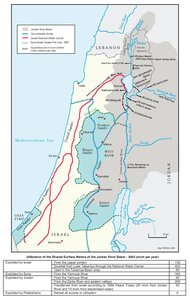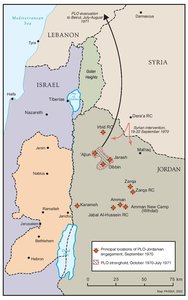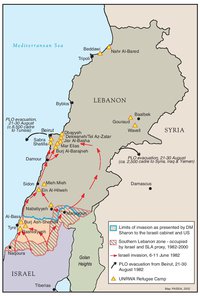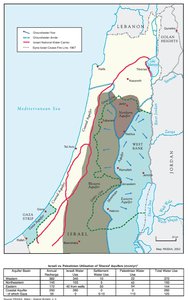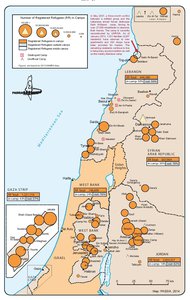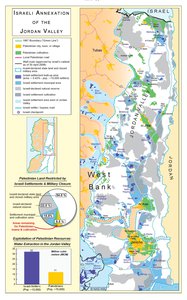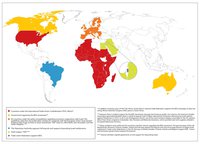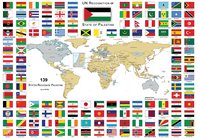SURFACE WATER
Map Details
Access to, and control over, the region’s limited water sources has always been a source of dispute in the
Middle East. In the context of the Palestine-Israel conflict, two principal sources of water are at stake – the
groundwater aquifers of the West Bank and Gaza Strip, and the permanent surface water flowing through
the Jordan River and its three major tributaries: the Hasbani, Dan and Banias rivers. The surface water
reaching or flowing through the Jordan River Basin is by rights the shared resource of Jordan, Syria,
Lebanon, Israel and the Palestinian West Bank – these being legally classified as ‘riparians’ by virtue of
their territorial location within the Basin area. International conventions and the principles of International
Customary Law forbid unilateral measures taken by states to seize control over shared water sources such
as those of the Basin, and supposedly guarantee the rights of all parties sharing water sources to “equitable
and reasonable” levels of utilization.
In contravention of these laws, and (later) the conventions governing the role of an occupying force, Israel
has - since 1951 - pursued a series of national plans aimed at exploiting the Jordan River Basin’s waters
unilaterally and extensively. The primary mechanism Israel employs to divert these waters is its National
Water Carrier, a series of canals, tunnels and pipes inaugurated in 1964, which transports 420-450 million
cubic meters (mcm) a year from Lake Tabariya (the Sea of Galilee) through the country’s coastal plain and
south to the Negev desert. The Carrier is connected to several regional Israeli systems and distributes 66%
of all the Basin water exploited by Israel. In addition to the Carrier, Israel diverts 130 mcm per year from the
Upper Jordan, and a further 90 mcm from Lake Tabariya directly to the surrounding agricultural and urban
centers. Israel’s total of 640 mcm per year represents 58% of all the water exploited in the Basin area, while
in terms of the Jordan River itself, Israel currently diverts at least 75% of the river’s waters before they
reach the West Bank.
The 1967 occupation of the Syrian Golan Heights left Israel in control of most of the Basin’s headwaters and
rendered its control of Lake Tabariya exclusive. Syrian access to the water sources of the Basin has
subsequently been confined to the Yarmouk River, which flows along its border with Jordan and is shared by
the two states. The 1994 Israeli-Jordanian Peace Treaty saw Israel yield to the Jordanians a mere 20 mcm per
year from the Jordan River, and agree to transfer a further 10 mcm of desalinated water. From 1960 to 2010
alone, the Jordan River flow has depleted from 1,300 mcm to 100 mcm. In lean periods the flow of the lower
Jordan River is even less than 10% of the annual flow (sometimes as low as 1 mcm per month).
Following the occupation of the West Bank in 1967 Israel destroyed or confiscated the 140 pumping units
located along the Jordan River in the West Bank. The diversion by Israel of three quarters of the river’s
flow has since left the Lower Jordan unviable as a water source even should Israel agree to eventual
Palestinian sovereignty in the area, as the salinity level is high and the rate of flow already critically low. The
river is no longer even capable of replenishing the Dead Sea, which is gradually receding as a result.
Military Order (MO) 92 of August 1967, transferred authority over water sources in the West Bank (both
ground and surface waters) to the military, and was followed the same year by MO 158, banning all
construction of infrastructure relating to water. In 1982, Israel’s national water company (Mekorot) took over
from the military, and today continues to control the flow and infrastructure of all the waters of or in the OPT.
The Palestinians have been denied absolutely any access to the shared resources of the Jordan River
Basin and as a result have remained entirely dependent on the groundwater of the hill aquifers and the
minimal ‘run off’ waters in the West Bank valleys during winter.
Denial of access to natural resources and failure to provide for the needs of an occupied population from
such resources represents a serious violation of both the 1910 Hague Regulations and the 1949 Fourth
Geneva Convention and has consequently been the subject of numerous UNGA and UNSC resolutions. In
1972, UNGA Resolution 3005 recognized that the Palestinian right to self-determination and statehood
embodies the right to the natural resources of the OPT, including its water. During the negotiating process,
the water issue was postponed to the final status talks, although the PA was able to establish the
Palestinian Water Authority (PWA), which operated as an administrative body but left Israel in absolute
control over the flow, price and development of the water network. The 2000-2001 final status talks did not
progress beyond the arrangements broached in the Interim (Oslo II) Agreement, which referred to Israeli
provision of immediate water needs according to a quota system but did not yield flow control or come close
to presenting the Palestinians with an “equitable and reasonable” level of utilization. As of 2013, West Bank
Palestinians have access to less water per capita than they did in 1993 and their reliance on purchasing
high-priced water from Israel has steadily increased. Future access to, and use of, the surface waters of
the Jordan River Basin remains a Palestinian necessity for sustainable development, particularly given
Israel’s drastic reduction in the yield and quality of the other major water sources – the OPT groundwater
aquifers.

